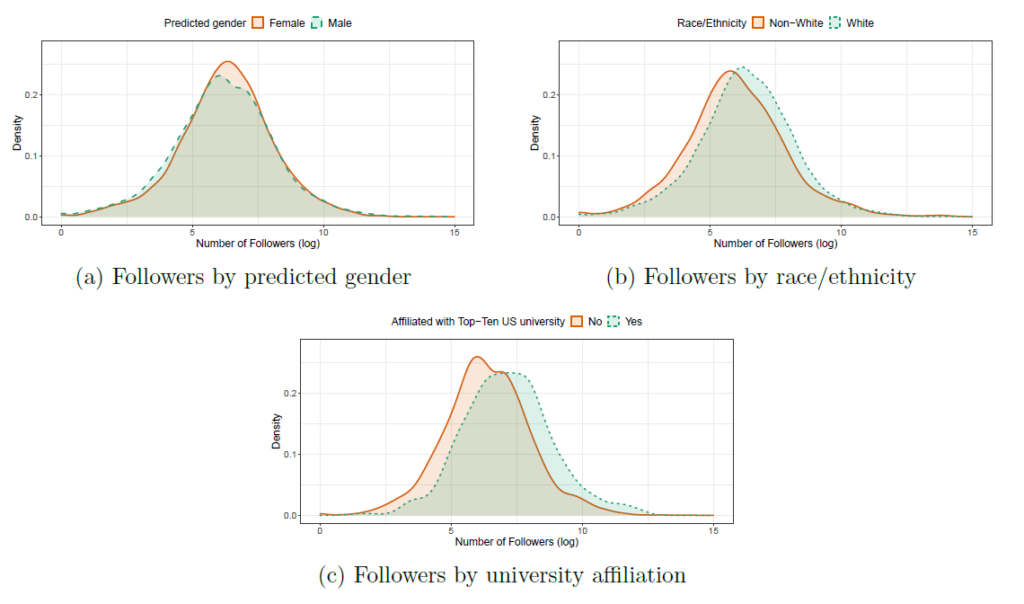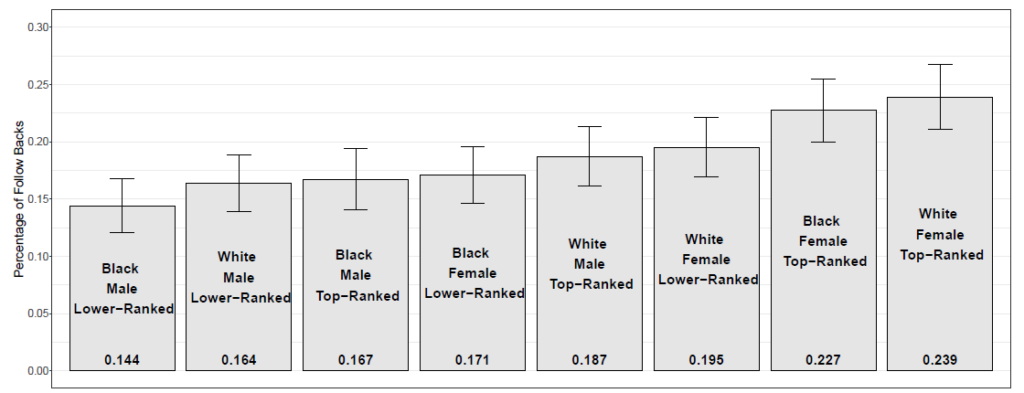In a field experiment conducted with economists on Twitter, the authors find that users who are identifiable as white, women, and PhD students affiliated with “top-ten” universities are more likely to receive follow-backs.
Professional networks are important determinants of labor market outcomes, especially in academia, where collaboration is critical. Nevertheless, individuals’ access to formal and informal academic networks is far from homogeneous. This heterogeneity may exist for several reasons, but a plausible cause is discrimination: do individuals with specific group-based characteristics such as gender, race, or university affiliation have lower access to networks due to discrimination based on these characteristics?
To test this hypothesis, we conducted a randomized experiment on Twitter, a social media platform widely used by academics to develop their professional networks. We created human-like fictional accounts that claimed to be PhD students in economics at universities in the U.S. The accounts were identical to each other apart from their perceived gender (male or female), race (Black or white), and university affiliation (one of the top-ten U.S. universities or a relatively lower-ranked university listed between 79-100, according to the 2017 U.S. News & World Report).
The experimental accounts randomly followed Twitter profiles of various economists from around the world. The subjects in our experiment are people who used the #EconTwitter in posts in January and February 2022.
Interestingly, we can use public information from Twitter to predict some of those users’ characteristics, such as their gender, race, and university affiliation. Even in the observational data from this sample, we find some disparities in the number of followers between different groups of economists, particularly in terms of the economists’ race and university affiliation. This is illustrated in Figure 1, which shows our subjects’ log number of followers according to their predicted gender, race, and university ranking (conditional on the subject being an academic economist). In the observational data, the gender of the economist has no impact on the number of their followers. However, the distribution of followers for white economists is shifted to the right relative to the distribution among non-white economists, suggesting the median white economist has more followers than the median non-white economist. Top-ranked university economists similarly have more followers than economists from lower-ranked institutions. However, many factors may explain the differences (or lack thereof) in the number of followers between these groups, such that these results alone are not evidence of discrimination. For example, publication records or the frequency of posts on the platform could correlate with the racial identity or university affiliation of economists who use Twitter, so that race or university affiliation do not themselves explain differences in the number of followers. Our experiment allows us to identify whether discrimination exists in these dimensions (and in which direction) since the accounts created are identical in all dimensions except those we study.
Figure 1: Distribution of followers on #EconTwitter

For the core experiment of our study, we created 80 fictitious accounts and followed about 8,000 economists on Twitter. Figure 2 gives examples of our experimental accounts: the profile picture (an artificially generated image) signals gender and race, while the profile’s description signals university affiliation. Names, both first and last, were selected from a list of common names according to the 2000 U.S. census. Names that indicated a specific ethnic minority group were removed from possible use. The experimental accounts randomly followed profiles of various economists. Then, after a few days, we measured the proportion of economists who reciprocally followed them back. By comparing the follow-back rate for each type of account, we could identify the existence (or not) of discrimination, since our accounts were identical except for the characteristics we manipulated.
Follow-backs are an interesting outcome in our setting because having many followers is essential to benefit from Twitter. The more followers an account has, the greater its potential impact and reach on this social network. Moreover, following an account back is a relatively low-cost action, suggesting that the disparities we find could be even larger in other (costlier) situations.
Figure 2: Sample experimental accounts

Overall, the follow-back rate varies substantially depending on the characteristics of the experimental accounts, as shown in Figure 3. For example, comparing the most extreme cases, we document that white women studying at prestigious universities were “followed back” in 23.9% of cases. In comparison, Black men from relatively less prestigious universities were followed back in only 14.4% of cases, a difference of over 65%. Strikingly, we also find that Black male students from top-ranked universities fare no better than white male students from lower-ranked institutions.
Figure 3: Follow-back rate by bot group

Figure 4 displays the main results of the experiment, comparing the marginal follow-back rate for each dimension we experimentally manipulated. Black students had a 10% less chance of receiving follow-backs than white students, while students who claimed to be studying at “top-10” U.S. universities received almost 22% more follow-backs than their relatively lower-ranked counterparts. In addition, women had 25% more follow-backs than men.
Figure 4: Follow-back rates by bot group, marginal distributions

The differences found are substantial and statistically significant at conventional levels. They quantitatively demonstrate disparities in access to academic networks among members of these different groups, which can contribute to the lack of diversity in the profession. The race and university affiliation results are consistent with economists’ perceptions and evidence of disparities in these dimensions.
However, the result for gender—subjects were more likely to follow back female than male accounts—runs counter to the overwhelming evidence, both within economics and in other contexts, of discrimination against women. We note that different mechanisms may be at play to explain this result. Some users, conscious of the barriers women face in the profession, could be attempting to engage more with women to correct those barriers. It is also possible that some subjects were using Twitter to establish social rather than professional connections and disproportionately wished to establish such connections with women. These two motives might have different implications regarding the consequences of having more Twitter followers on women’s professional outcomes. While we cannot elicit the motivation behind each follow-back, considering how this effect varies by different subgroups of subjects may provide us some hints about this behavior (e.g., male subjects follow back female bots at a higher rate than female subjects).
Overall, by documenting that discrimination is indeed present in the context of the formation of academic networks, we aim to contribute to the debate about the lack of diversity in academia. Nevertheless, much more research on the topic is needed to understand, for instance, the motivation behind follows and how discrimination occurs in different stages of professional interactions. Still, our results indicate that, even on a platform regarded as democratic and egalitarian, different groups face different barriers to networking, which may reduce the potential benefit these groups obtain from the social media presence.
Articles represent the opinions of their writers, not necessarily those of the University of Chicago, the Booth School of Business, or its faculty.






